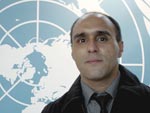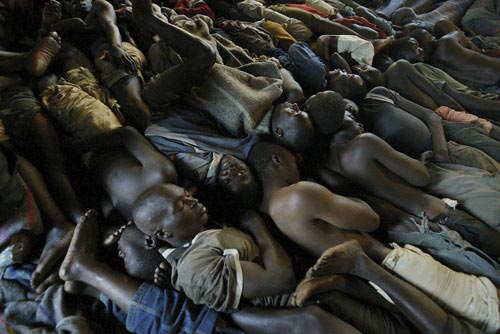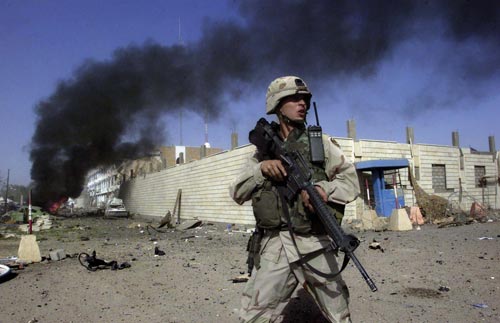João Silva: On the frontline
As a child, the Lisbon-born photographer moved with his parents to the then Portuguese colony of Mozambique before resettling in South Africa, where he got his first glimpse of racism. He has kept his eyes wide open ever since, camera in hand, eager to show the world "how screwed up the human race is" and to help bring about change.
|
|
|
Blantyre, June 29, 2005: Prisoners sleep in cramped positions before being woken up at dawn inside an overcrowded cell in the Maula Prison in Blantyre, Malawi. Some cells have as many as 160 prisoners. Malawi prisons have a good human rights record but they are overcrowded and many of those incarcerated have been on remand for several years due to lack of financial and legal resources. Photo: João Silva for The New York Times. |
During the late 1980s and early 1990s, he covered the escalating violence that marked his adopted land's transition from apartheid to democracy. Since then, in Angola, Sudan, Afghanistan, Iraq and other hotspots, he has covered humanitarian crises, internal conflicts and wars. As a photojournalist for The New York Times, he currently spends six months a year in Iraq, at times on the receiving end of U.S. fire.
João Silva spoke with Perspectives Editor Norha Restrepo after presenting his work on Malawian prisons at the Commission on Crime Prevention and Criminal Justice at UNODC headquarters in Vienna.
What was it like to grow up as an immigrant in South Africa?
South Africa was such a polarized nation that even as a white immigrant you were not necessarily welcome in that closed Afrikaner-type society. So the first exposure I had to racism was not really what was happening in the social fabric of the country but the intolerance that was directed towards foreigners. The whole social situation was obviously wrong and needed to change and, as a journalist, my focus was clear. My career started in 1989 as apartheid was coming to an end, as the political violence was escalating to the point of madness. And it was clear-cut what my role was going to be.
What is your analysis of the situation today?
South Africa has made huge, huge progress. Absolutely. It is a better country. People are free. It has its problems, ranging from HIV to unemployment, but South Africans are finally in control of their own country and that's a good thing.
Why do you expose yourself to human suffering?
I guess it's curiosity, wanting to see history unfolding before your eyes. Maybe it has to do with my personal experience with independence in Mozambique and the Portuguese fleeing the colonies for fear of retribution. And then there's the simpler stuff: I enjoy doing it. You spend a lot of time in war zones but you don't spend all your time getting shot at. There are days when there is a certain amount of adrenalin and I get a kick out of that. For the most part, there is a need to show the world how complex and how screwed up the human race is.
You've seen strangers and even friends die.
Death compounded by death affects you as a human being. But, certainly, when somebody you know dies, somebody you care about, it gives you a whole different perspective. You do go through emotional trauma. What it also does is bring closer to home the realities of a war zone. The fact that you're there as a camera, that you're there as a non-combatant, does not exclude you.
Unfortunately, some friends of yours have killed themselves as well.
Yes, two to be exact. The most famous case, of course, is Kevin Carter, who won a Pulitzer prize for a picture of a young Sudanese child being stalked by a vulture. People often ask me if the horrors that he saw were the reason. My answer is always that they were not the sole reason. There's always something in the personality that takes people to those extremes but his experiences covering conflict certainly pushed him over the edge. The interesting thing about Kevin's case is that he took his life three months after winning the Pulitzer, the most coveted award in journalism. There lies the irony: getting that award made life more complicated for him. It compounded the guilt he felt about having survived and having kind of profiteered from other people's suffering.
You've worked a lot with the UN.
My experience has been that UN assistance in places like Sudan and Angola is invaluable. In Angola, during the war, you could only travel if you got onto a WFP [World Food Programme] flight. People were always hospitable and helpful on the ground. In many situations, it is very difficult for journalists to work without that assistance. The UN has always been, in my opinion, a great friend to journalists and when I say the UN I'm obviously speaking of different agencies under its umbrella.
|
|
|
Baghdad, August 19, 2003: A U.S. soldier is photographed at the burning United Nations compound after a huge bomb exploded destroying part of the building. Photo: João Silva for The New York Times. |
You were in Baghdad when the UN compound was bombed.
At the time, we had no idea where the bombing had occurred. We were in our [ New York Times] bureau when there was this massive explosion that reverberated throughout the city and then huge plumes of smoke streaked the sky. We chased after it. When we arrived on the scene, it was mass destruction. I got there maybe 10-12 minutes after the explosion and chaos reigned. Casualties were crawling out of the building, which was still on fire. The American soldiers that had been guarding the place were kind of disorientated, securing the area but saying: 'God, what's just happened?' Sadly, it was the beginning of something bad and it hasn't stopped. It just goes to show that in that kind of situation, even if you're an NGO, the ICRC [International Committee of the Red Cross] or whoever, you're not exempt. The boundaries have changed so much.
Your book In the Company of God is an account of the time you spent with Iraq's Shia Muslims.
The book focuses on faith, politics, sacrifice and war. The first part of the book talks about the Shiite faith and how it differs from the Sunni faith. The second part is about sacrifice, including suicide bombings. The third part consists entirely of combat images from the last Shiite uprising in Iraq, when I spent a whole month embedded with Shiite militias. It was pretty crazy, pretty chaotic. Being on the other side of American fire is astonishing. There were some very, very dangerous moments that were captured in the pictures. The final part of the book is about the democratic process that started in early 2005 with the elections.
Your pictures of Malawian prisons have moved many people around the world.
 Surprisingly, the Government gave us all the access we needed and was totally open about the challenges it faces in dealing with overcrowded and congested prisons. In a way, this willingness to show the world the problems it is facing might be a plea for help to the international community. The photos you saw were taken during a two-day visit to Maula Prison. The day begins when a select group of prisoners is let out to work outside the compound, to chop wood and get the cooking fires going. Then, at six o'clock, the rest of the population is let out into the yards. These prisoners spend an average of 14 hours every day in a room that contains 100-150 people. It is so tight that prisoners sleep interlocked. They are so crammed that they cannot turn over in their sleep, so each cell has a prisoner whose task it is to wake everybody up at a certain point in the evening so that they can all turn over at the same time, to be a little bit more comfortable and get the circulation going. As you can expect with that kind of congestion, hygiene is a problem. People are sick. But as African prisons go, it is not the worst, not by far. Living conditions are harsh but prisoners are not being abused. It was amazing to see. My initial reaction was: 'This must have been what the slave ships were like, all those years ago, when they used to carry human cargo. All those people packed like sardines.'
Surprisingly, the Government gave us all the access we needed and was totally open about the challenges it faces in dealing with overcrowded and congested prisons. In a way, this willingness to show the world the problems it is facing might be a plea for help to the international community. The photos you saw were taken during a two-day visit to Maula Prison. The day begins when a select group of prisoners is let out to work outside the compound, to chop wood and get the cooking fires going. Then, at six o'clock, the rest of the population is let out into the yards. These prisoners spend an average of 14 hours every day in a room that contains 100-150 people. It is so tight that prisoners sleep interlocked. They are so crammed that they cannot turn over in their sleep, so each cell has a prisoner whose task it is to wake everybody up at a certain point in the evening so that they can all turn over at the same time, to be a little bit more comfortable and get the circulation going. As you can expect with that kind of congestion, hygiene is a problem. People are sick. But as African prisons go, it is not the worst, not by far. Living conditions are harsh but prisoners are not being abused. It was amazing to see. My initial reaction was: 'This must have been what the slave ships were like, all those years ago, when they used to carry human cargo. All those people packed like sardines.'

